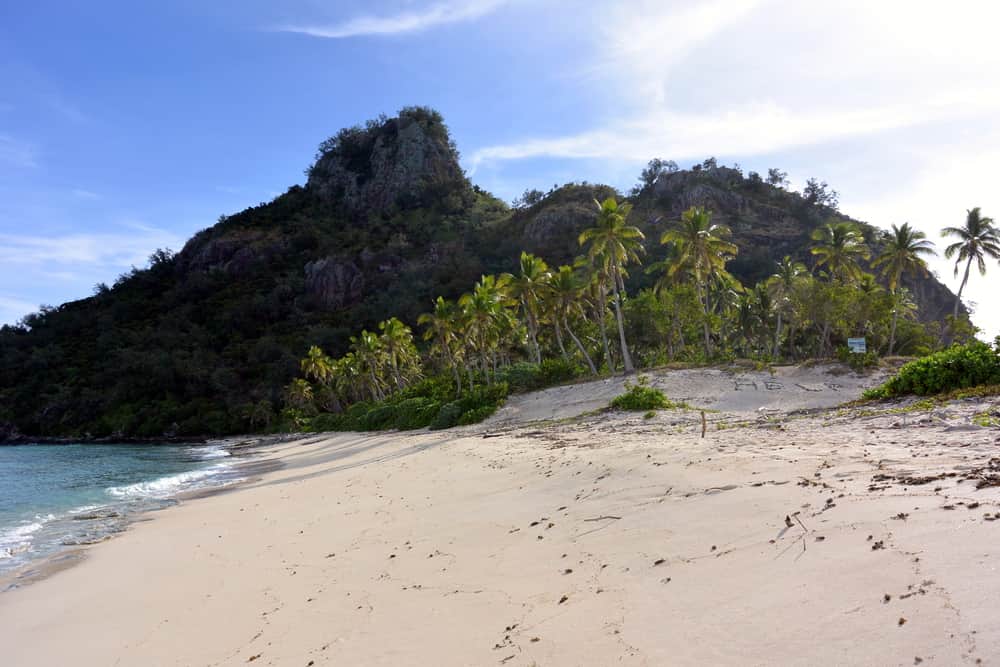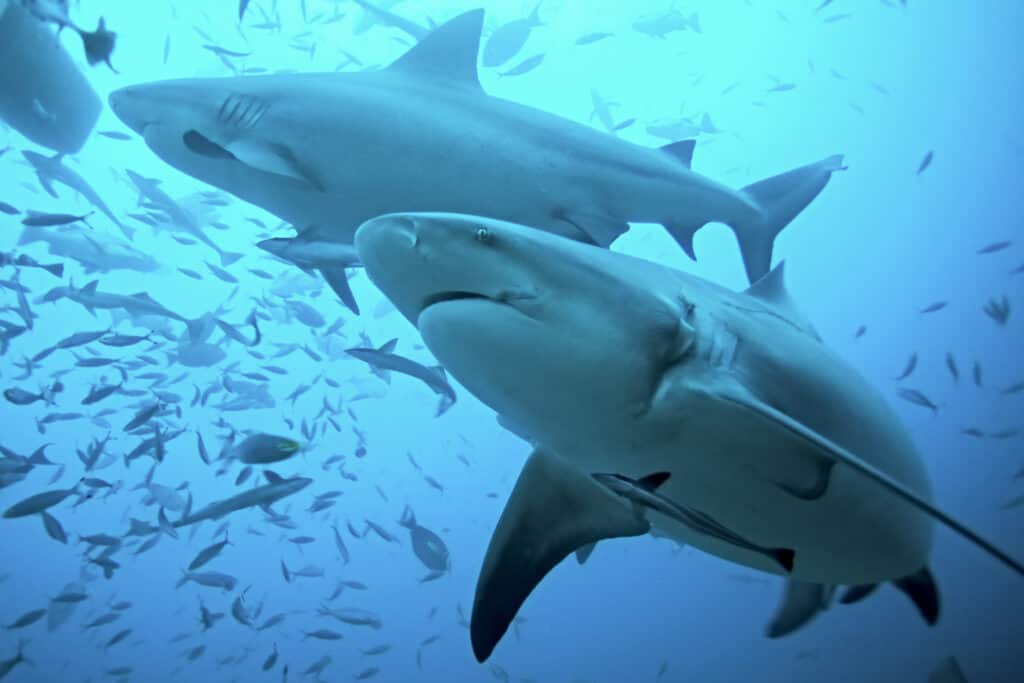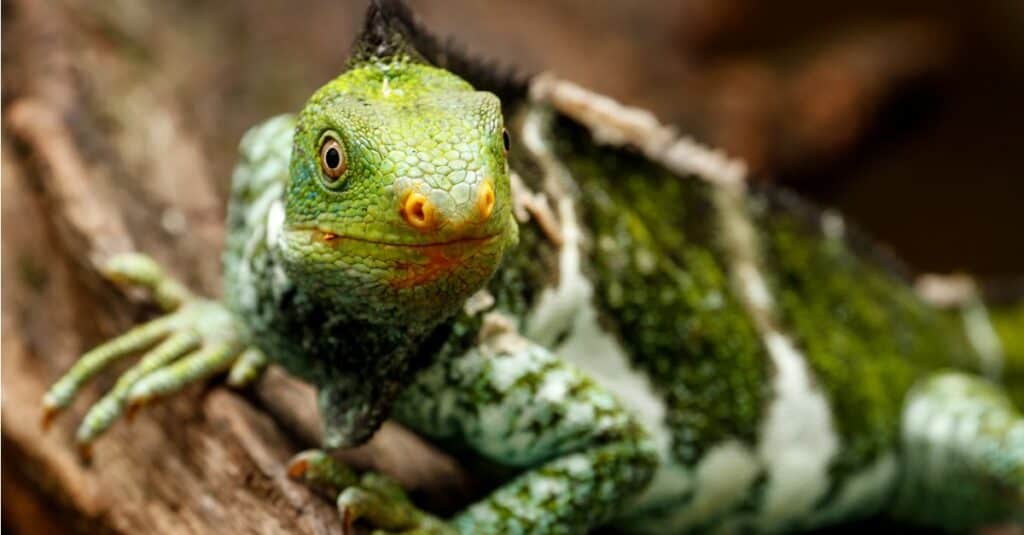When a FedEx systems analyst becomes the only survivor of a plane crash in the Pacific Ocean, he must learn to survive and adapt to his new life as a castaway with a volleyball, packages, and his own sanity if he wants a chance of returning home.
Cast Away broke box office records when it debuted, grossing $429 million worldwide. Tom Hanks, who played the titular role, received a nomination for — and won — the Golden Globe for Best Actor in a Motion Picture Drama.
However, the real star of the movie wasn’t Tom Hanks, or Wilson the volleyball — it was the location. With crystal blue water and sandy beaches, the real location of the uninhabited island in the movie is a pretty amazing place to discover.
Where Was Cast Away Filmed?

The uninhabited island of Monuriki in Fiji hosted 100+ crew members for the filming of
Cast Away.
©Paolo Ponga/Shutterstock.com
The majority of Cast Away was filmed on Monuriki Island (also known as Modriki Island). Other locations used for short scenes in the movie included Red Square in Moscow, Memphis, Tennessee, and near the small towns of Canadian and Miami, Texas.
Monuriki Island is one of the Mamanuca Islands in Fiji. While all of Fiji is a popular tourist destination, this island in particular exploded in popularity after the movie premiered. It is the smallest (only 100 acres large) and southernmost island in the Atolls Islands group, which is a subset group of islets contained in the Mamanuca Islands cluster. The coral and volcanic island is situated off the coast of Viti Levu, west of Tavua.
Monuriki is uninhabited, but there is a tribe of people who act as custodians to keep it in the best shape. The Yanuya people, who inhabit the nearby island Yanuya, have an agreement with several international, environmental, and government agencies to care for the island. There are also agencies that have worked to restore the bird habitats on Monuriki since 2011.
The larger group of islands, the Mamanuca Islands, are a volcanic archipelago to the west of the Nadi Islands and to the south of the Yasawa Islands. The collection consists of nearly 20 different small islands, though seven of them become completely submerged during high tides, so they’re not inhabitable.
Challenges of Filming on Monuriki Island
As locations go, Monuriki wasn’t too unwieldy for a filming location. Most of the challenges came down to external forces, like Tom Hanks growing his hair out and both gaining and losing weight to depict the years he was stuck on the island.
However, one incident on the island led to a three-week halt in production. Thanks to a cut from an unidentified object on set — and Tom Hanks’ method acting decision to not bathe — the cut became infected. The crew rushed him to a nearby hospital, where a physician confirmed the cut was not only infected with Staph but eating its way through Hanks’ leg. Hanks had no idea his cut was infected and ended up staying in the hospital for three days as they controlled the infection so it wouldn’t get into his bloodstream. Production only picked back up when Hanks fully recovered.
Red Square, Tennessee, and the Texas Panhandle
The quick shot of Tom Hanks giving a lecture to FedEx employees at the beginning of the movie actually did take place in Russia’s Red Square, right in front of St. Basil’s Cathedral in Russia. In the early 1990s, when the USSR dissipated, filmmakers flocked to the location for stunning views of Ivan the Terrible’s timeless creation.
The crew took a pit stop in Memphis, Tennessee in an unassuming neighborhood called Hedgemoore next. That’s where they filmed the short but emotionally-fraught reunion scene between Tom Hanks’ and Helen Hunt’s characters.
At the very end of the movie, when Tom Hanks’ character is at a literal crossroads in his life, he’s actually in the Texas panhandle. The Arrington Ranch House Lodge in Canadian, Texas played the home of the last package’s recipient.
Minutes later in the movie, as Tom Hanks’ character drives down the crossroad, he’s at the real-life intersection of FM1268 at FM 48 in Mobeetie, Texas.
Best Time to Visit Monuriki Island

Most of the year, Monuriki Island has beautiful weather.
©Marco Ramerini/Shutterstock.com
The entire country of Fiji is warm year-round, making any time a great choice to explore the Mamanuca Islands — including Monuriki.
Weather
Monuriki has a tropical marine climate and remains pretty warm most of the year. The warm season in Monuriki ranges between November and April, with the “cooler” season — which is still a balmy 72 degrees Fahrenheit — following in May and stretching to October. Extreme weather, like hail, typhoons, or massive thunderstorms, is a rarity. While extreme weather isn’t common, rain is. Inland, rainfall is heavy but comes in short bursts. Cyclones happen, but not too often. The wind isn’t too unbearable either. Monuriki may get one or fewer cyclones a year, resulting in between eight and 12 cyclones within a decade.
Because you can’t stay on Mondriki, you’ll also want to stay aware of the weather for other Fiji islands nearby, or even the mainland itself. While all have a very similar climate, some islands have mountains on one side that make half of the island wet and rainy while the other side is much drier. If you’re eager to see the lush greenery of the islands, the best time to go is the rainy season.
Tours of Monuriki Island
Affectionately known as “Cast Away Island Beach,” the shores of Monuriki remain open to fans of the movie. Many of the neighboring islands that have hotels and resorts on them feature Cast Away-themed excursions. These experiences, however, come with the understanding that there is nothing on the Monuriki Island beach save the flora and fauna.
Most of the organized tours fall into one of three buckets:
- Guided land tour.
- Snorkeling/diving tour.
- Self-guided tour.
Guides who know the island and the movie will deftly walk you through the most iconic places and scenes, giving you an in-depth look at where production set up cameras to create the movie. Public and private charters of boats, on the other hand, focus on introducing visitors to the vast coral reef surrounding the island. Finally, self-guided tours simply open up the island for you to explore.
Things to Do
When planning a trip to Monuriki or “Cast Away Island Beach,” be careful not to accidentally book a trip to Castaway Island, which is a different and completely separate island in Fiji also known as Qalito Island. Boating out to the island usually takes about 45 minutes from the nearby resorts and hotels, and many visitors report getting splashed along the ride.
Monuriki Island has a plethora of flora and fauna to walk through and discover, as well as some picturesque photo ops. Many visitors take to finding sticks and rocks to create their own “Help Me” signs in the sand like in the movie. The main attraction of the island is simply enjoying its beauty. People walk up and down the beaches, swim in the water, explore the forest, and even find coconuts to carve open and enjoy fresh coconut water. Remember, however, the Leave No Trace policy for good ecotourism, and be sure to leave the island exactly as you found it.
Some adventurers and families opt for a more exciting tour of the island, either with jet skis or snorkeling. As a coral reef surrounds the island, excursions exist to swim through the reef that teems with wildlife. The jet ski tour currently offered has a three-hour journey past Monuriki Island and around other nearby islands.
Did you know that the show Survivor also films on the Mamanuca Islands? Once you’ve gotten your fill of Monuriki, hop over to some of the other islands to see where Survivor shot seasons 33 to 45.
Flora and Fauna of Monuriki Island

Monuriki Island is home to bull sharks, the Fiji crested iguana, and many other marine animals.
©Martin Prochazkacz/Shutterstock.com
The coastal and marine life of Monuriki Island, and the rest of the Mamanuca Islands, are so significant, they are valued and protected within Fiji’s Biodiversity Strategy and Action Plan.
Flora
Most of the vegetation on the island coincides with the plants standard of a rainforest, though on a much smaller scale. The tropical dry forest vegetation of Monuriki allows for coastal forest plants to grow, including the pandanus tree, coconut tree, and broadleaf trees. Some of the other naturally-occurred plants that you can find amid Monuriki’s vegetation include:
- Velvetleaf trees.
- Beach morning glory.
- Notched cowpea.
- Oriental mangrove.
- Portia tree.
- Paradise plum.
Monuriki’s tropical dry forest climate is rare, meaning the fragile ecosystem in Monuriki demands the conservation of the tropical forest and its surrounding habitats. Many of the animals that live on the island depend on their specific diet and shelter from those plants that only grow in this climate.
Fauna

Monuriki is a protected reserve and habitat for the Fiji crested iguana, a critically-endangered species.
©iStock.com/Donyanedomam
Monuriki is home to several threatened species, which is why the island remains so important to Fiji’s biodiversity. Most notably, it’s one of the few places in the world where the Fiji crested iguana lives. It’s also the breeding ground for sea turtles, which lay their eggs in the sand in hopes the babies will hatch and make it to the ocean.
Monuriki has a unique ecosystem that provides shelter to many species of threatened or endangered animals (like the Fiji crested iguana). It is the largest colony of wedge-tailed shearwater (if you combine its population with the population of the nearby Kadomo and Matamanoa islands) as well, though many migratory birds frequent the island.
Outside of the island itself, the coral reef surrounding it has a diverse population of marine life. Reef sharks, turtles, parrot fish, barracuda, eel, and various coral reef fish swim in the waters. When booking a snorkeling trip, be sure the charter pays attention to how the boat interacts with the coral. Preserving the vastly-untouched reef is critical in maintaining its beauty and the habitats of the animals that live there.
Wilson!
The real-life location of Cast Away is a breathtaking island located in the South Pacific Ocean with dozens of species of birds, coconut trees, soft beaches, and stunningly-blue water. It’s uninhabited, meaning the natural beauty of the island can persist without the pollution of tourism, industry, and more.
Getting to Monuriki Island is a long travel day for most people, but the views alone are worth the wait. Nearby hotels on larger islands offer daily and weekly trips to Monuriki for visitors to reenact their favorite scenes from the movie, take a swim, or just experience the warm beach.
By practicing responsible ecotourism and respecting the wildlife, visitors to Monuriki Island will keep it a once-in-a-lifetime destination for others for years to come.
The photo featured at the top of this post is © Paolo Ponga/Shutterstock.com
Thank you for reading! Have some feedback for us? Contact the AZ Animals editorial team.






